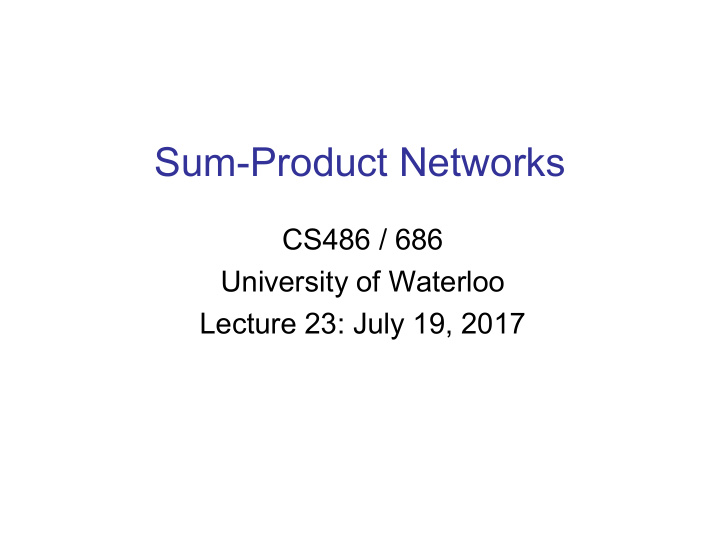



Sum-Product Networks CS486 / 686 University of Waterloo Lecture 23: July 19, 2017
Outline • Introduction – What is a Sum-Product Network? – Inference – Applications • In more depth – Relationship to Bayesian networks – Parameter estimation – Online and distributed estimation – Dynamic SPNs for sequence data CS486/686 Lecture Slides (c) 2017 P. Poupart
What is a Sum-Product Network? • Poon and Domingos, UAI 2011 • Acyclic directed graph of sums and products • Leaves can be indicator variables or univariate distributions CS486/686 Lecture Slides (c) 2017 P. Poupart
Two Views Deep Tractable architecture probabilistic with clear graphical model semantics CS486/686 Lecture Slides (c) 2017 P. Poupart
Deep Architecture • Specific type of deep neural network – Activation function: product • Advantage: – Clear semantics and well understood theory CS486/686 Lecture Slides (c) 2017 P. Poupart
Probabilistic Graphical Models Bayesian Markov Sum-Product Network Network Network Graphical view Graphical view Graphical view of direct of correlations of computation dependencies Inference Inference Inference #P: intractable P: tractable #P: intractable CS486/686 Lecture Slides (c) 2017 P. Poupart
Probabilistic Inference • SPN represents a joint distribution over a set of random variables • Example: CS486/686 Lecture Slides (c) 2017 P. Poupart
Marginal Inference • Example: CS486/686 Lecture Slides (c) 2017 P. Poupart
Conditional Inference • Example: • Hence any inference query can be answered in two bottom-up passes of the network – Linear complexity! CS486/686 Lecture Slides (c) 2017 P. Poupart
Semantics • A valid SPN encodes a hierarchical mixture distribution – Sum nodes: hidden variables (mixture) – Product nodes: factorization (independence) CS486/686 Lecture Slides (c) 2017 P. Poupart
Definitions • The scope of a node is the set of variables that appear in the sub-SPN rooted at the node • An SPN is decomposable when each product node has children with disjoint scopes • An SPN is complete when each sum node has children with identical scopes • A decomposable and complete SPN is a valid SPN CS486/686 Lecture Slides (c) 2017 P. Poupart
Relationship with Bayes Nets • Any SPN can be converted into a bipartite Bayesian network (Zhao, Melibari, Poupart, ICML 2015) CS486/686 Lecture Slides (c) 2017 P. Poupart
Parameter Estimation Instances ? ? Attributes Data ? ? ? ? ? ? • Parameter Learning: estimate the weights – Expectation-Maximization, Gradient descent CS486/686 Lecture Slides (c) 2017 P. Poupart
Structure Estimation • Alternate between – Data Clustering: sum nodes – Variable partitioning: product nodes CS486/686 Lecture Slides (c) 2017 P. Poupart
Applications • Image completion (Poon, Domingos; 2011) • Activity recognition (Amer, Todorovic; 2012) • Language modeling (Cheng et al.; 2014) • Speech modeling (Perhaz et al.; 2014) CS486/686 Lecture Slides (c) 2017 P. Poupart
Language Model • An SPN-based n-gram model • Fixed structure • Discriminative weight estimation by gradient descent CS486/686 Lecture Slides (c) 2017 P. Poupart
Results • From Cheng et al. 2014 CS486/686 Lecture Slides (c) 2017 P. Poupart
Summary • Sum-Product Networks – Deep architecture with clear semantics – Tractable probabilistic graphical model • Going into more depth – SPN BN [H. Zhao, M. Melibari, P. Poupart 2015] – Signomial framework for parameter learning [H. Zhao] – Online parameter learning: [A. Rashwan, H. Zhao] – SPNs for sequence data: [M. Melibari, P. Doshi] CS486/686 Lecture Slides (c) 2017 P. Poupart
Recommend
More recommend